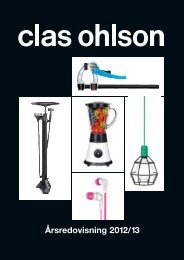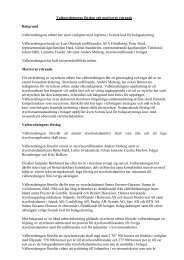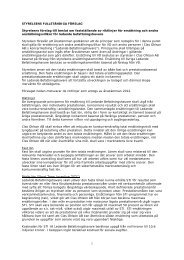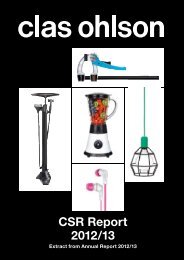Annual Report 2012/13 - Clas Ohlson
Annual Report 2012/13 - Clas Ohlson
Annual Report 2012/13 - Clas Ohlson
You also want an ePaper? Increase the reach of your titles
YUMPU automatically turns print PDFs into web optimized ePapers that Google loves.
vary. Each Board meeting is normally to be devoted to a<br />
specific topic so that the Board can gain more in-depth<br />
knowledge and understanding of the various parts of the<br />
company’s operations. There are also presentations on<br />
these topics by employees of the company.<br />
The issues that the Board dealt with during the year<br />
included strategic direction, monitoring of the business<br />
plan, a review of risk management, significant business<br />
processes, development of current markets and future<br />
expansion.<br />
The work of the Board’s committees is an important<br />
element of the Board’s work. The Board has prepared<br />
instructions for the committees’ work. The Remuneration<br />
Committee and Audit Committee discuss issues that fall<br />
within the committees’ remit. Issues that have been addressed<br />
in the committee meetings are minuted and notified<br />
to the other Board members at the Board meetings.<br />
The rules of procedure also state that the Board must<br />
meet with the company’s auditors at least twice per year.<br />
In addition, the rules of procedure also regulate certain formal<br />
matters, such as rules for the notification of meetings<br />
and secrecy.<br />
Audit Committee<br />
At its first meeting following the AGM, the Board established<br />
an Audit Committee comprising Urban Jansson,<br />
Chairman, Cecilia Marlow and Lottie Svedenstedt. The<br />
Board has issued instructions for the Committee work. The<br />
Audit Committee fulfils the guidelines regarding independence<br />
in the Swedish Corporate Governance Code. The<br />
Audit Committee is responsible for the quality assurance<br />
of financial reporting. In addition, the Audit Committee<br />
is responsible for supervising the effectiveness of risk<br />
management and internal control in respect of financial<br />
reporting. The members of the Audit Committee met the<br />
auditors on two occasions during the financial year to learn<br />
about the focus of the audit and discuss views on the risks<br />
faced by the company. In addition, the auditors attended<br />
several of the committee’s other meetings. Important tasks<br />
for the Audit Committee are to serve as a communication<br />
link, between the Board and the company’s auditors<br />
and to establish what services over and beyond auditing<br />
can be procured from the company’s auditors. The auditing<br />
effort is evaluated annually, after which information is<br />
passed to the Nomination Committee on the outcome.<br />
The Audit Committee held seven meetings during the<br />
financial year. The attendance is shown in the table on<br />
page 53. The meetings are minuted and reported at the<br />
next Board meeting. Representatives of the company’s<br />
management and the company’s internal controller attended<br />
the committee’s meetings as co-opted members. The<br />
meeting also addressed issues aimed at quality assuring<br />
risk management and internal control relating to the financial<br />
reporting. Moreover, the Audit Committee dealt with<br />
issues regarding the company’s interim reports, annual<br />
report, accounting, liquidity and other issues.<br />
Remuneration Committee<br />
A specific Remuneration Committee was appointed by<br />
the Board comprising the Chairman of the Board Anders<br />
Moberg and three other Board members, Sanna Suvanto-<br />
Harsaae, Björn Haid and Edgar Rosenberger. The Board<br />
has issued instructions for the Committee’s work. The<br />
Remuneration Committee fulfils the guidelines pertaining<br />
to independence as stated in the Swedish Corporate<br />
Governance Code.<br />
The Remuneration Committee submits proposals for<br />
guidelines pertaining to basic salary and variable remuneration<br />
for senior management. The process regarding variable<br />
remuneration for all staff works in a similar way. The<br />
Committee met four times during the financial year. Attendance<br />
is shown in the table on page 53. The meetings<br />
were minuted and reported at the next Board meeting.<br />
The Remuneration Committee addressed such issues as<br />
fixed and variable remuneration, and evaluated the current<br />
long-term incentive programme (LTI).<br />
Distribution of work between the Board and CEO<br />
The Board appoints the Chief Executive Officer (CEO) of<br />
the company. The distribution of work between the Board<br />
and CEO is indicated in the Board’s rules of procedure and<br />
in the instructions to the CEO. These state that the Board<br />
is responsible for the governance, supervision, organisation,<br />
strategies, internal control, forecasts and policies of<br />
the company. In addition, the Board decides on major<br />
investments and matters of principle relating to the gover-<br />
The Board’s working schedule<br />
May June July Aug Sept Oct Nov Dec Jan Feb Mar Apr<br />
<strong>Annual</strong> report<br />
AGM<br />
Monthly updates of the business operations, outcome, KPI etc.<br />
Operation planning<br />
• Dividend proposal<br />
• Year-end report<br />
• Financial reporting<br />
• Monitoring of the business<br />
plan/forecast<br />
• <strong>Annual</strong> accounts for the<br />
preceding financial year<br />
• Risk reporting<br />
• Meeting with auditors<br />
• Strategy meeting<br />
• Interim report, Q1<br />
• Financial reporting<br />
• Monitoring of the<br />
business plan/forecast<br />
• <strong>Annual</strong> General Meeting<br />
• Statutory Board meeting<br />
• Interim report, Q2<br />
• Financial reporting<br />
• Monitoring of the<br />
business plan/forecast<br />
• Risk reporting<br />
• Meeting with auditors<br />
• Interim report, Q3<br />
• Financial reporting<br />
• Monitoring of the<br />
business plan/forecast<br />
• Forecast for future<br />
financial years<br />
• Decision about the business plan<br />
• Decision pertaining to<br />
remuneration issues<br />
52<br />
Corporate governance














